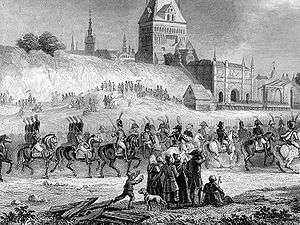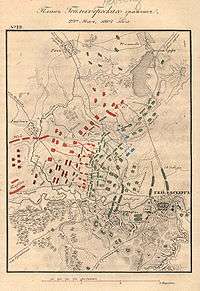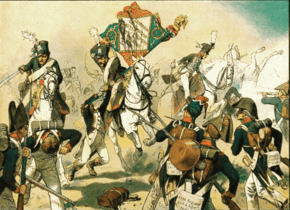Battle of Heilsberg
| Battle of Heilsberg | |||||||
|---|---|---|---|---|---|---|---|
| Part of the War of the Fourth Coalition | |||||||
 Battle of Heilsberg. Etching by unknown artist. | |||||||
| |||||||
| Belligerents | |||||||
|
|
| ||||||
| Commanders and leaders | |||||||
|
|
| ||||||
| Strength | |||||||
| 65,000[1] | 53,000[1][2] | ||||||
| Casualties and losses | |||||||
| 1,398 killed, 10,059 wounded, 864 captured[1] | 6,000 killed and wounded[1][2] | ||||||
The Battle of Heilsberg took place on 10 June 1807, during the Napoleonic Wars.[3]
Overview
On 24 May 1807, the Siege of Danzig ended when Prussian General Friedrich Adolf, Count von Kalckreuth capitulated to French Marshal François Joseph Lefebvre. With Danzig (modern day Gdańsk) secured, Napoleon was now free to turn against Bennigsen's army. Yet it was the Russian who struck first when he ordered his columns to converge on Marshal Michel Ney's exposed VI Corps on 2 June. Outnumbered 63,000 to 17,000, Ney fought a brilliant rear guard action at the Battle of Guttstadt-Deppen on 5 and 6 June. Though he lost his baggage train, two guns, and 2,042 men, Ney managed to escape to the southwest over the Pasłęka (Passarge) River with the bulk of his soldiers, leaving Bennigsen seething with rage over his missed opportunity.
Within two days, Napoleon ordered his 190,000-man army to close in on the 100,000 Russians and 15,000 Prussians. Detecting the approaching avalanche, Bennigsen ordered his troops to retreat on Lidzbark Warmiński (Heilsberg). The Russian army took up strong defensive positions around the town, which stood on the Łyna (Alle) River. The French army, under Marshals Murat and Lannes, attacked on 10 June. Bennigsen repelled several attacks, resulting in huge French casualties, but had to withdraw towards Friedland the following day. Four days later, the decisive Battle of Friedland occurred, ending the War of the Fourth Coalition with the passing of the Treaty of Tilsit.
Influences on the battle
Geography
The Battle of Heilsberg was fought on the Alle river, known today as the Lyna. The Teutonic Castle being the focal point of the battle was held by Russian control.
Terrain
Aside from geographical advantages, the Russians had also spent three to four months compiling tactics on how to defend against a French invasion, regardless of where they would attack the castlegrounds. Defensively, the castle was supported by its bridges and walls, both of which were built along the perimeter of the castle. The land surrounding the Teutonic Castle acted as an obstacle for the French army due to the increase of elevation from the base of the river to the castles foundation.
Climate
Although the terrain was punishment enough for the French, weather also took a toll on their abilities and health. During the day, on top of the weight being carried in regards to supplies and armory, temperatures reached dangerously hot and humid levels. The dampness and bitter cold of the night also played a significant role by providing little opportunity for rest.
Strategies and tactics
Beginnings of the battle The French were initially outnumbered by the Russians, and knowing this, positioned themselves to cut off any opportunity for the Russians to obtain reinforcements. At the beginning of the battle, French army men were separating amongst their own divisions. This tactic was thought to help block Russian sights in terms of all the French positioning and flanking. Although the woods surrounding the French had provided a perimeter of camouflage, the shrubbery did not extend to the barren field in front of the castle. It was because of the forest density, however, that dodging the Russian artillery and infantry fire was difficult to maneuver around.
Middle/End of the battle In the midst of war, French cavalry leaders Murat, Soult, and Lannes had segregated their troops from the greater unit, which would soon result in utter failure. After such separation, the smaller units within the reserves had refused orders to flank and attack stronger sides of the Russian armies. This was partly because orders being issued by reserves of the secondary infantry, rather than Marshalls and Major Generals, were not given enough of credit of leadership in their absence. Despite both sides losing a significant number of men, each refused to withdrawal their armies. The realization of the large number of French soldiers who had already been a victim of death, and the success of the Russian defense gave Bennigsen and Napoleon little choice but to call an undocumented truce to end the war. This truce was signaled when both sides focused solely on the health of wounded soldiers rather than that of offensive tactics. By leaving behind weaponry as proof of their intent, medics and soldiers alike began helping those who were wounded, or retrieve the dead.
Outcome and post-war analysis This battle is recognized as having been tactically indecisive due to neither side having gained any significant ground, it is most notably discussed as a battle that yielded little change in the balance of strength between the Russians and the French. The Battle of Heilsberg was fought four days before the decisive Battle of Friedland.
French Army men accounting 1,398 killed, 10,059 wounded, 864 captured[1]
Russian Army men accounting 6,000 killed and wounded[1][2]
| Phase 1 | Phase 2 | Battle picture by Knötel |
|---|---|---|
 |  |  |
Notable officers of the French Army present were:
- Commandant in chief : Napoléon Bonaparte
- Marshall Louis-Alexandre Berthier, prince de Neuchatel
- Marshall Joachim Murat
- Marshall Nicolas Jean-de-Dieu Soult
- Marshall Jean Lannes
- Major General Nicolas Charles Oudinot
- Major General Jean-Antoine Verdier
- Colonel François-Joseph d'Offenstein (made Brigadier general further to this battle)
Notable officers of the Russian Army present were:
- Commandant in chief : Bennigsen
- Marshall Matvei Platov
- Marshall Prince Gorchakov
- Marshall Dmitry Dokhturov
- Marshall Prince Bagration
- Major General Fabian Steinheil
References
- 1 2 3 4 5 6 Clodfelter M. Warfare and Armed Conflicts: A Statistical Reference to Casualty and Other Figures, 1500-2000. McFarland, 2002. P. 169
- 1 2 3 Roberts A. Napoleon: A Life. Penguin Group. 2014. P. 450
- ↑ Theodore A. Dodge (2001). Napoleon: A History of the Art of War. Adamant Media. ISBN 1-4021-9517-6.
External links
- Spring Campaign 1807. Heilsberg — one of the bloodiest battles of the Napoleonic Wars
- Battle of Heilsberg
- Battlefield Anomalies: The battle of Heilsberg
- French and Russian Order Of Battle of Heilsberg
- Heilsberg and the battle (German)
- La bataille de Heilsberg (French)
- 2007 г. Lidzbark Warminski—первая реконструкция сражения посвященная 200 летию.
- Napoleans Campaign in Poland
- Map Database of Heilsberg
Coordinates: 54°07′00″N 20°35′00″E / 54.1167°N 20.5833°E